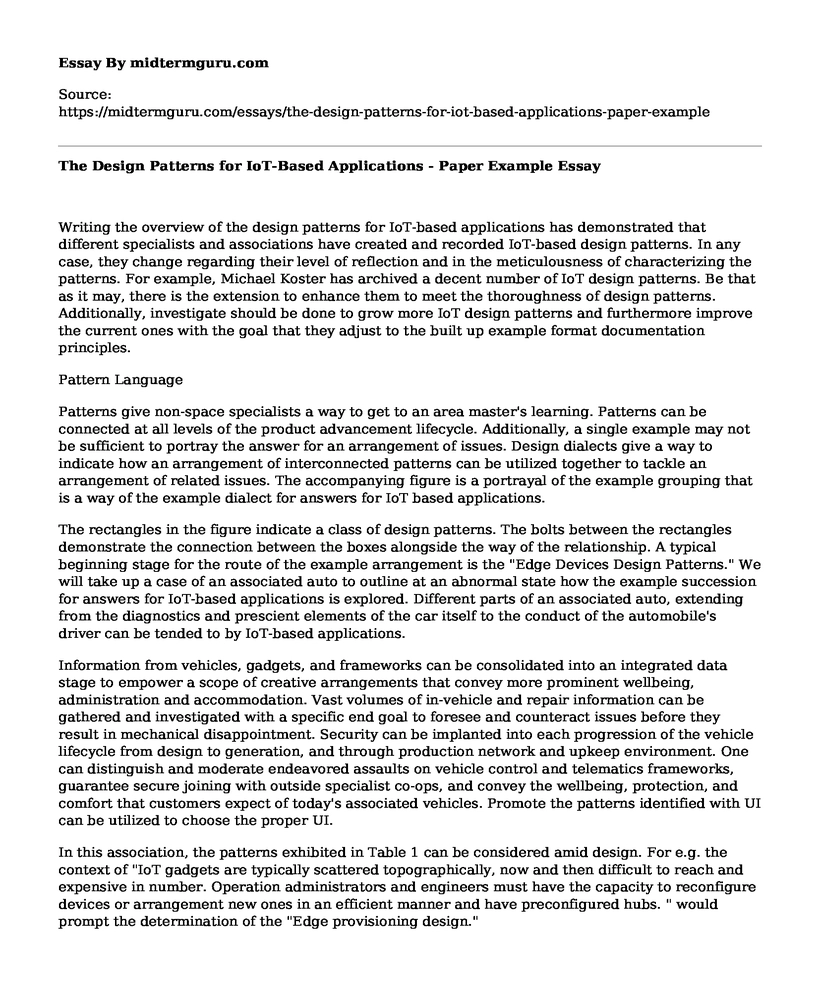Writing the overview of the design patterns for IoT-based applications has demonstrated that different specialists and associations have created and recorded IoT-based design patterns. In any case, they change regarding their level of reflection and in the meticulousness of characterizing the patterns. For example, Michael Koster has archived a decent number of IoT design patterns. Be that as it may, there is the extension to enhance them to meet the thoroughness of design patterns. Additionally, investigate should be done to grow more IoT design patterns and furthermore improve the current ones with the goal that they adjust to the built up example format documentation principles.
Pattern Language
Patterns give non-space specialists a way to get to an area master's learning. Patterns can be connected at all levels of the product advancement lifecycle. Additionally, a single example may not be sufficient to portray the answer for an arrangement of issues. Design dialects give a way to indicate how an arrangement of interconnected patterns can be utilized together to tackle an arrangement of related issues. The accompanying figure is a portrayal of the example grouping that is a way of the example dialect for answers for IoT based applications.
The rectangles in the figure indicate a class of design patterns. The bolts between the rectangles demonstrate the connection between the boxes alongside the way of the relationship. A typical beginning stage for the route of the example arrangement is the "Edge Devices Design Patterns." We will take up a case of an associated auto to outline at an abnormal state how the example succession for answers for IoT-based applications is explored. Different parts of an associated auto, extending from the diagnostics and prescient elements of the car itself to the conduct of the automobile's driver can be tended to by IoT-based applications.
Information from vehicles, gadgets, and frameworks can be consolidated into an integrated data stage to empower a scope of creative arrangements that convey more prominent wellbeing, administration and accommodation. Vast volumes of in-vehicle and repair information can be gathered and investigated with a specific end goal to foresee and counteract issues before they result in mechanical disappointment. Security can be implanted into each progression of the vehicle lifecycle from design to generation, and through production network and upkeep environment. One can distinguish and moderate endeavored assaults on vehicle control and telematics frameworks, guarantee secure joining with outside specialist co-ops, and convey the wellbeing, protection, and comfort that customers expect of today's associated vehicles. Promote the patterns identified with UI can be utilized to choose the proper UI.
In this association, the patterns exhibited in Table 1 can be considered amid design. For e.g. the context of "IoT gadgets are typically scattered topographically, now and then difficult to reach and expensive in number. Operation administrators and engineers must have the capacity to reconfigure devices or arrangement new ones in an efficient manner and have preconfigured hubs. " would prompt the determination of the "Edge provisioning design."
Limitations
The traditional approaches to data discovery and systems intelligence have two failings: they cant provide a holistic view of these diverse data types and, the types of intelligence tools available to users are, at best, arcane and typically not accessible to the people that have the application domain knowledge. The ability to detect patterns in data is the holy grail of smart systems and The Internet of Things be-cause it allows a whole higher order of intelligence to emerge from large collections of common data. The implications are obviously immense, but given the immature state of todays real-world systems, most people have trouble grasping the power and importance these capabilities can enable.
CONCLUSIONS AND FUTURE WORK
Numerous perspectives can characterize patterns. A decent grouping can make their determination less demanding and more exact [11]. We have adopted a strategy of grouping patterns given the different layers of the Layered Architecture Layer that IoT-based applications typically take after.
This approach forces a top-down component of guaranteeing that important design patterns have been distinguished for every one of the layers. As each layer manages an arrangement of particular worries, for e.g. the concentration of the edge gadgets layer is on gadgets, and for the correspondence layer the emphasis is on will be on communication instrument. Subsequently, Subject Matter Experts (SMEs) can concentrate on distinguishing proof of design patterns in their general vicinity of mastery. Therefore, if SMEs are made a request to remark on the patterns that frame some portion of the layer comparing to their mastery then other design patterns could rise.
References
Mahindra (2016). Security and Privacy in Internet of Things (IoTs). doi:10.1201/b19516
Cite this page
The Design Patterns for IoT-Based Applications - Paper Example. (2021, Jun 09). Retrieved from https://midtermguru.com/essays/the-design-patterns-for-iot-based-applications-paper-example
If you are the original author of this essay and no longer wish to have it published on the midtermguru.com website, please click below to request its removal:
- Project Failure Reflection Blog - Paper Example
- The Cyber Security Implementation Plan in the Healthcare System
- Personal Statement Example: MSc in Software Engineering
- SMS Phishing: Deceitful Attack on Your Mobile Devices - Research Paper
- Internet: From Origin to Global Society Impact - Essay Sample
- 3M: Gaining Success Through Key Presentations & More - Essay Sample
- Digital Market Plan: Leveraging Microcomputers' Life Cycle - Essay Sample







